How did the canyon country once look, in a different time and in a different world? Maybe a few hundred or thousands of years ago? In many respects, especially when it comes to our precious slickrock, the changes would almost be imperceptible. But in other ways, and in the relative blink of an eye, our part of the world is very different.
For example, in the 90s, scientists discovered a pack rat midden in a deep cave near Delicate Arch. In all that ancient excrement, they found nuts from a yellow pine, a tree that now only grows in the La Sal Mountains, some thirty miles away and 4000 feet higher in elevation. Did a pack rat carry a pine cone down the mountain, across the river, and up Salt Wash to its final resting place? No…more likely, the rats gathered these nuts from nearby pines when the trees grew prolifically at a lower elevation, in the vicinity of that cave. Later, carbon testing of the pine cone remnant and the midden pile confirmed that they were more than 12,000 years old.
Arches must have looked very different then. Imagine tall pine forests surrounding the Windows area of Arches National Park and in Winter Camp Wash below Delicate Arch. The climate was cooler and wetter then, and the park probably bore a semblance to present-day Bryce Canyon.
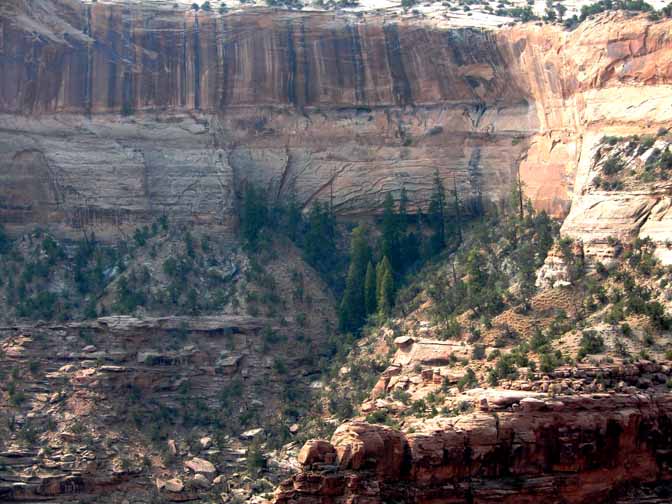
WHAT IS A REMNANT FOREST?
According to people who know what they’re talking about, “a remnant natural area, also known as remnant habitat, is an ecological community containing native flora and fauna that has not been significantly disturbed by destructive activities such as agriculture, logging, pollution, development, fire suppression, or non-native species invasion.” The more disturbed an area has been, the less characteristic it becomes of remnant habitat. Remnant areas are also described as “biologically intact” or “ecologically intact.
They’re rare but if you look hard enough, or if the National Park Service is eager enough to promote it as a “scenic attraction,” then you might see a “remnant natural area from time to time.
I first became aware of remnant natural areas not long after I moved to Moab. There were no signs back then, promoting these oddities, but on my first trip to the Island-in-the Sky district of Canyonlands National Park, a ranger friend of mine said, “Be sure to check out the Doug Firs.”
“What?” I said. “Here?” He explained the whole ‘remnant’ concept and sure enough, when I reached the Neck, I searched the shadows on the north face of the tall sandstone walls and spotted them. Amazing, I thought. I found myself applying anthropomorphic attributes to the trees. Their tenacity. Their courage. Their willingness to adapt — you know. That NEVER SURRENDER mantra. It was really just sheer luck, a little extra water via dripping springs and more shade than one might find at 6000 feet. But still, we all like to think that
Thosea few hardy Douglas Firs maintain a foothold on a shaded northern cliff face. There must have been thousands of firs at one time. Now this relative handful is all that remains of that forest.
BUT WHAT ABOUT THE OUTLIERS?
But there are other lifeforms…trees as well as other living things…that technically grow within the range they are intended to thrive. But sometimes they can be found in locations where it still seems unlikely, or even impossible. And yet, there they are, clinging to life, on a part of the planet where you can’t find another of its kind for miles or tens of miles…or more. Biology books will say that Ponderosa Pines can grow as low as 5800. But latitude plays a role too. Depending on the kind of tree, 5800 feet may be way too low for a Ponderosa to survive. And of course it depends on moisture. Is there a creek nearby? A perennial spring?
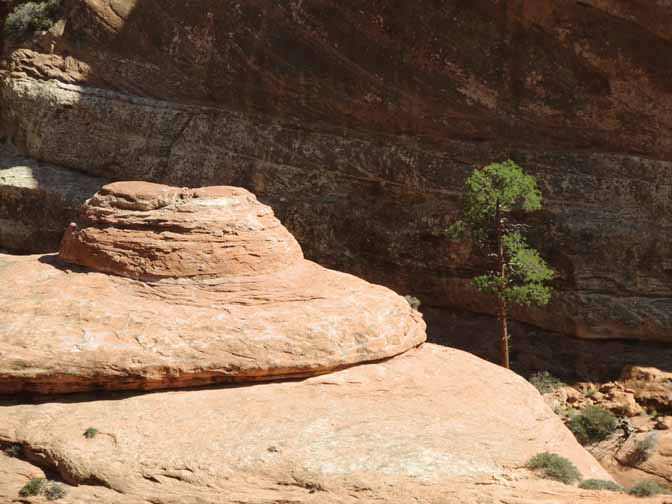
They probably still qualify as “remnant habitat,” but I like outliers better. My first experience with outlier trees was along the old dirt alignment of Utah Hwy 95. Fifty years ago, the road crossed Comb Ridge several miles north of the current massive road cut. It forded Comb Wash, climbed the mesa, then crossed to the east side of the current highway near that roadside ruin. For miles there was nothing but pinyon/juniper. Hot dry. Maybe 6000 feet elevation? Then suddenly, in just one side drainage stood a stand of magnificent Ponderosas. I was a rookie then…certainly not much of a naturalist. Still the tiny forest felt special to me. I lingered a while, then headed west and was right back in the p/j. It must have been another several miles before I spotted anotherponderosa down in one of the side canyons south of the road. solar
Once the new highway was built, the Ponderosas were forgotten, though even from the paved road, you can see the little stand of Ponderosa in the distance. One interesting sidebar…the new highway DID reveal just one outlier Ponderosa…somewhere between Comb Wash and the Arch Canyon Ruins….I’ll let you search for it. .
****
Forty years ago, I bought some land in San Juan County. It had been an 800 acre ranch and the plan was to turn them into many, many ten acre lots with full utilities and paved roads. But the developer went broke and none of those improvements ever happened. A miracle in my estimation. The land is almost all oak, pinyon and juniper. There are maybe four or five very young outlier Ponderosas within sight of the cabin. It’s mostly wide open sage brush meadows.
But soon after I bought the land, I started taking some walkabouts to see what was out there. Less than a quarter mile away, I discovered a small shady canyon, filled with one hundred year old Ponderosas.
But that’s not what surprised me. As I followed the sandstone creek bottom, in the shade of the Ponderosas, I came upon a steep drop off, of maybe 50 feet. At the bottom of that fall was a magnificent stand of aspens. As we mostly know, an aspen grove is really just one living organism, all connected by its root systems. This was odd. I have never seen another aspen grove within five miles, but more importantly, less than 1500 feet higher in elevation. These aspens, a relic of another time, have survived.
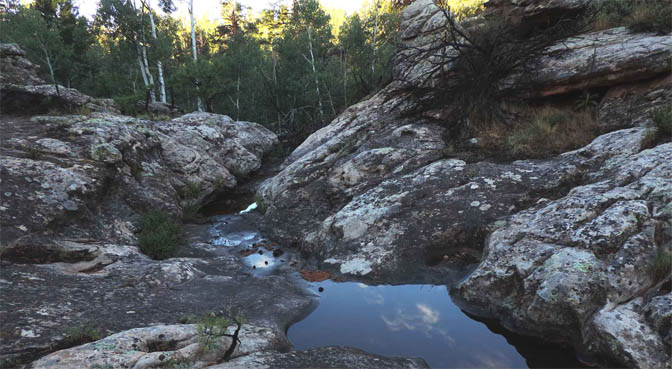
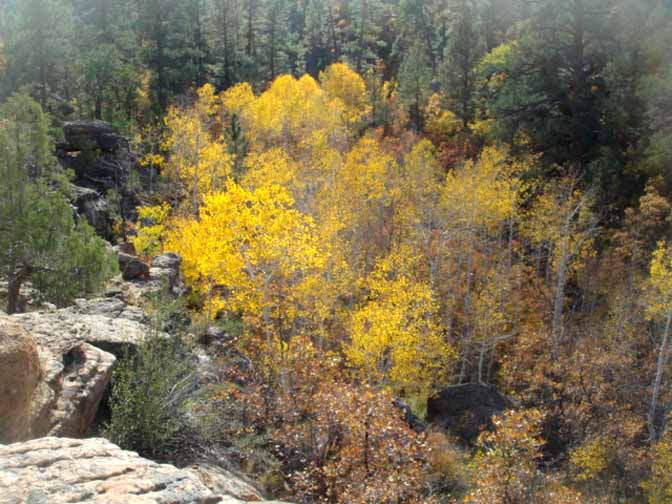
*****
Until recently, my favorite remnant/outlier was a lone Ponderosa Pine tree. A big one. It must be sixty or seventy feet tall; its trunk is about three feet in diameter. The Ponderosa leans against a sandstone overhang and, in fact, it’s the alcove that probably allowed the pine to grow in the first place. It began its life under the alcove. The overhang must have provided enough shade for the seedling to sprout and grow and it must have taken years for the little tree to reach its rocky lip and grow beyond it. Now the pine cuts into the sandstone itself.
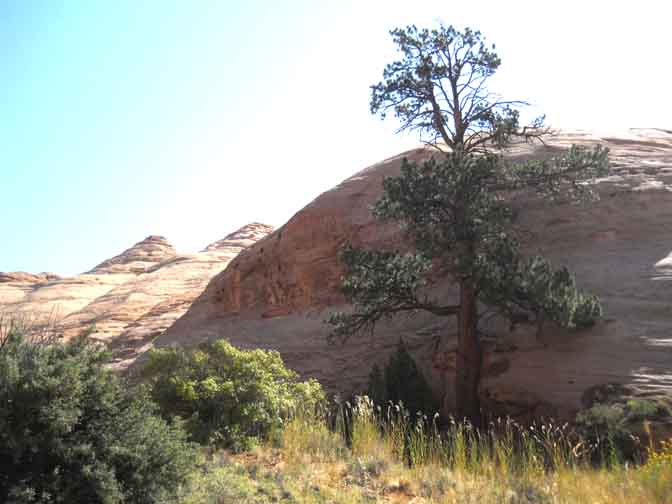
But why is it there? The Ponderosa grows on a sandy shelf above the water course in a sandstone canyon. It’s not even close to its “normal” elevation range. I searched up and down the canyon for more pines but my lonely ponderosa was all that I could account for. So, is this tree the last remnant of a Ponderosa forest that once covered these canyons, many thousands of years ago? Or is just an interloper of sorts?
I checked my maps to see if the Ponderosa lived in a canyon whose source was in the mountains—I thought maybe a cone might have been carried here by a flash flood, but the canyon was a short one, with no access that I could see to higher elevations. I sought other possibilities, Did a bird with a penchant for pine nuts, plant the seed? or perhaps a “Johnny PonderosaSeed,” was out here out planting pines in the desert a hundred years ago. Or maybe a rancher, moving his stock from summer range down to the river had a steer with a pinecone stuck in its hoof. Or if it was a really dumb steer —maybe he’d eaten a pinecone and then deposited what was left under the alcove. I he did indeed ingest the cone, I hope it didn’t go in backways. Ultimately I could find no logical explanation. But the tree IS there.
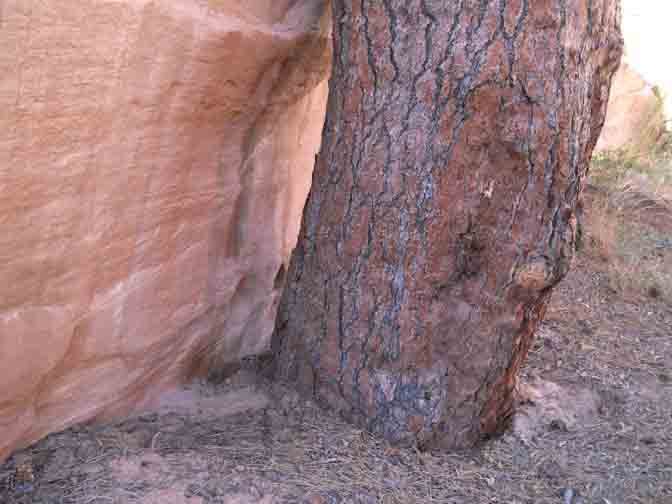
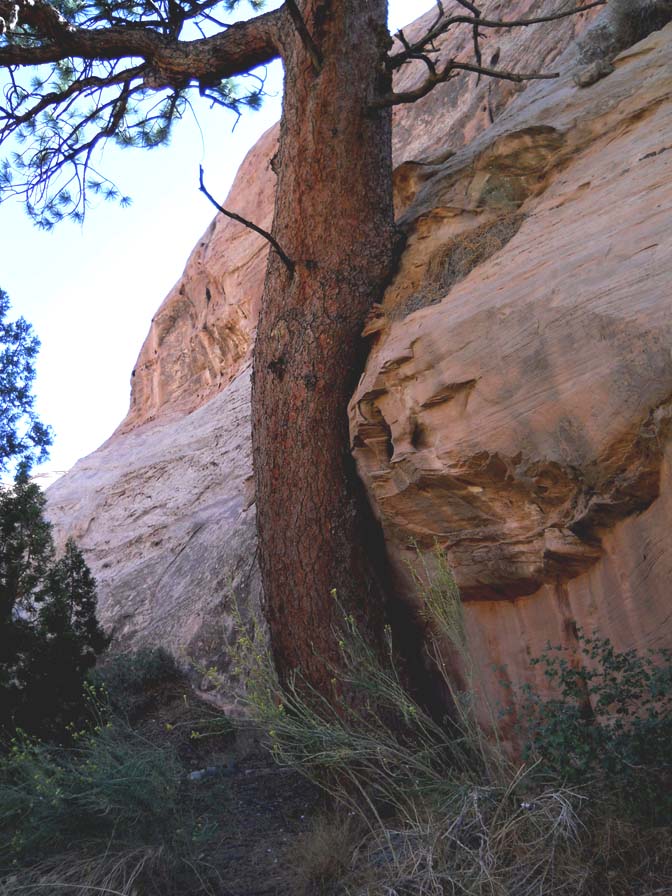
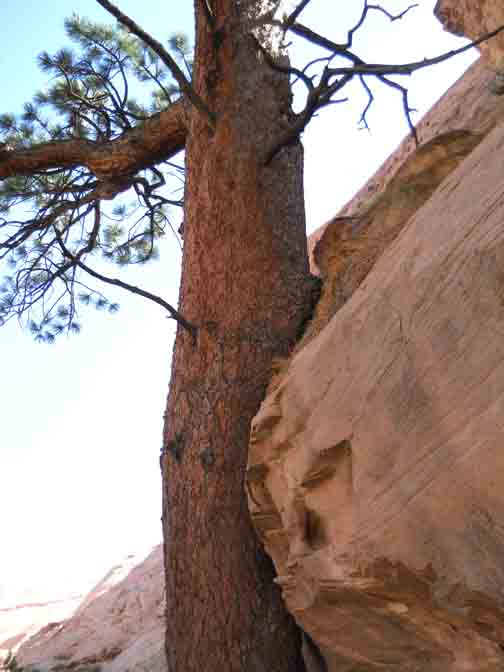
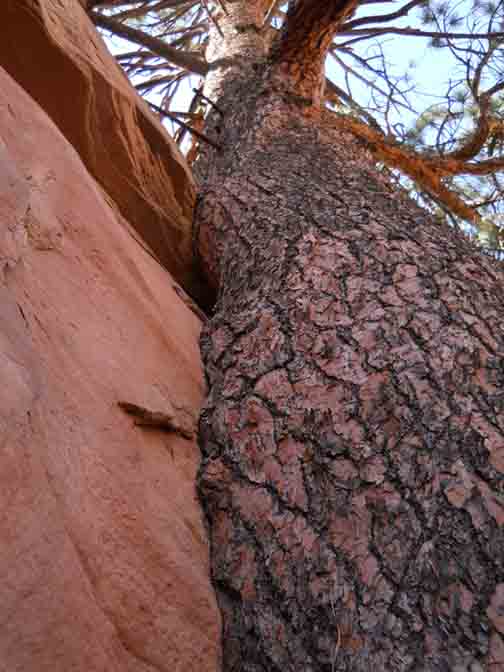
****
And then finally, the grove of trees that, to me at least, makes no sense at all…To all you botanists out there. WTH? Explain this to me…
A few years ago, I was taking a shortcut toward Clayton, New Mexico, which is in the very upper right corner of the state. It’s about 15 miles from the Oklahoma State Line. Not only are there no forests, there aren’t any trees…at all. Literally. You can look for miles and miles and you might see a stray cottonwood tree by its lonely self. Or maybe an elm tree that was planted there by a bird with a taste for elm. But otherwise, one would be hard put to keep a 10 x 10 foot cabin warm by chopping wood. If you did, your heat supply would be depleted in about 30 days.
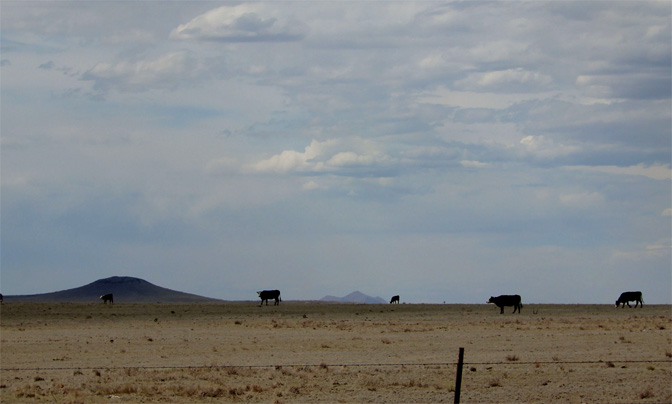
And yet…I’m driving along this terrible little barely paved road, a “road” that has more holes than asphalt, and I find myself descending a slight hill. Up ahead, there is…what should I call it? A small ridge? A hill? Maybe a hummock. Beneath it is what passes for a stream with real running water. But at the base of the hummock I see some trees and they look out of place. It’s winter time and the trees are of course leafless. I look closely. Wait a minute. The trunks of all these trees are…is that possible? Asp?
I parked my car at the bottom of the gill and got out. I hopped a fence and realized the ground was wet… even soggy. It was as if I’d found some kind of spring. I walked through the mud to examine the trees…
They were ASPENS. What in the hell was a grove of aspen trees doing out here? At least 75 miles from the nearest aspen grove. Miles from ANY tree. At an altitude and longitude that made no sense at all. I admit I’m no naturalist; it was Abbey who once said the “ only birds he could recognize without hesitation were the turkey vulture, the fried chicken and the rosy bottom skinny dipper.” Likewise, I’m not a botanist or expert on trees. But I DO know an aspen tree when I see it. And this was a grove of aspen trees. On the High Plains of far east New Mexico. With a few New Mexican junipers, and not another tree in sight.
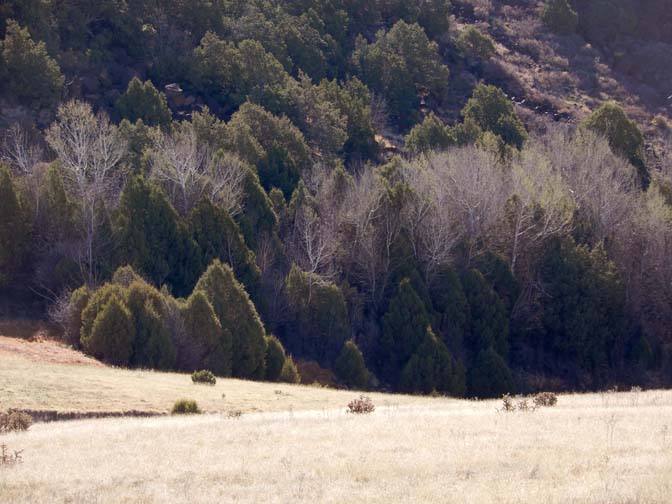
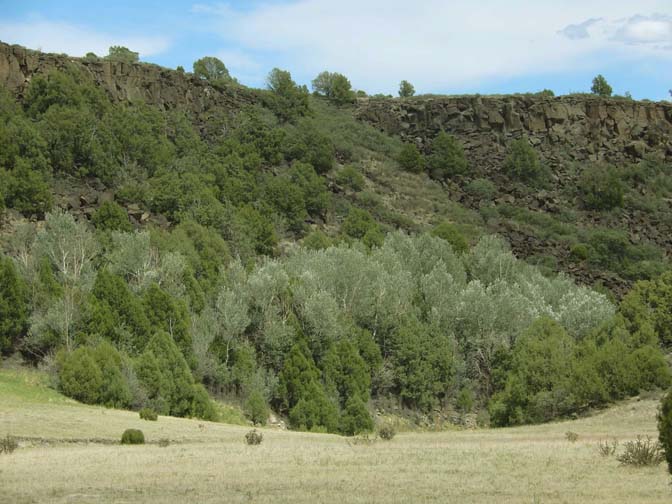
These trees, I thought to myself, are holy trees. Just like that lonely Ponderosa. Miracles of Nature. When I saw those aspens, way out here on the treeless prairie, as I waded through the mud for a closer look, and I stood and touched their bark, and realized…these are real, I almost said a prayer. These trees are defying the norm. They are living and thriving despite their own improbability. Screw the rules on Nature, they had said— we are here to stay.
These trees are the outliers…the living entities that defy the rules. They laugh at the impossible. They are here despite every reason to deny their existence. I lthese trees. These rebellious aspens are an expression of my own longing for a defiant soul. So is that lonely Ponderosa. And my little copse of aspens near the cabin…and the Douglas Firs that have to carry the media load and publicity for the rest of them. (“Hey Marge! Look at that funny pine tree! They say it’s a R-E-M-N-A-N-T tree!!! Let’s take a selfie! We’ll put us on Instagram!!!”
Still…those other outliers—They give me a bit of hope.
AND WHAT ABOUT THE HUMAN OUTLIERS?
Still I worry about the remnants and the outliers. And Life in general, especially in the over loved and overused Southwest. This relentless drought —climate change for whatever reason– has taken a toll on all the trees in my heart of homes. The junipers and pinyons have, over the last twenty years, and at my cabin’s hard dry season, I noticed that the leaves on the oaks were less than an inch long— mini-leaves. Normally I’d expect the oak leaves to be four or five inches long. It’s what Nature does to survive— it consolidates and only maintains what it hopes can keep alive. During the worst drought year in San Juan County that I can recall—the summer of 2002 — the oak trees produced no leaves at all. It was the summer that looked like winter in July. The next year, we got a good snow pack and spring rains, and the oaks survived, but in many cases, the top five or seven feet of the tallest oaks were stone dead. The trees basically had to start over again. But they found a way to live
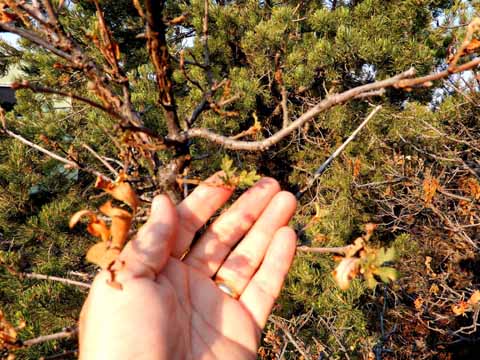
Ultimately, I decided I prefer NOT to know, or even try to understand why the Lonely Pine has survived. Or the aspens. What matters to me is that while the world becomes more homogenous and less interesting, there are still mysteries and anomalies to be found, even in unremarkable little canyons. And out there on the lonely prairie. These are the inexplicable living entities that listened to the beat of a different drum. Wanderers and dreamers. These trees dreamed of deserts never seen or prairies known, and now call it home.
*****
o, But maybe I want to see the same resilience in humans. I want to applaud their stubborn refusal to give up, to surrender to humanity’s inevitable fate.
I’m grateful to those human outliers, scraping out a life, hanging way out there on the edge, refusing to acknowledge the fate that inevitably awaits our species. Those…rugged individuals… a word now considered blasphemous by some of America’s most vocal (and wealthy) environmentalists, are still here. Those crusty souls who refuse to accept their designated fate, who repudiate the notion that our future lies in the “collective.”
I long for the man or woman who turns his or her back on the homogeneity of our changing world. I embrace the people who would rather live simply than bury themselves in mortgages and debt. I salute the Nomadlanders.
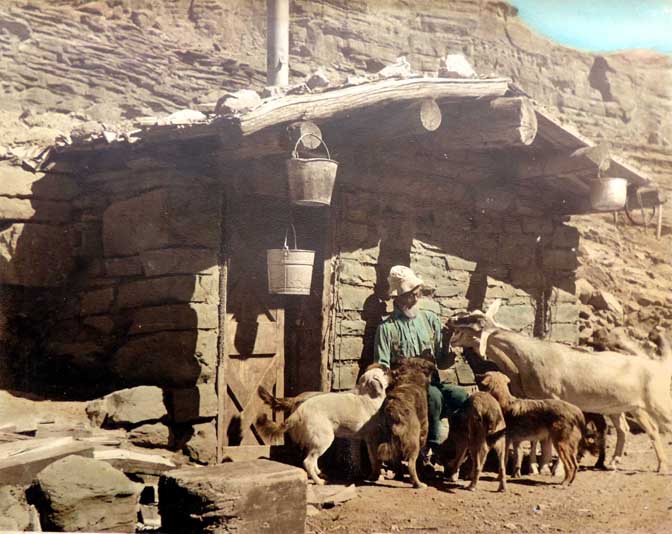
I think about the outliers who are long gone, but who lived to the beat of a different drum, decades ago. I’d bet Jack Holley, the Goat Man of Moab, would find a lot in common with that lonely ponderosa. Or the “King of the World, Ahron Andrew; he was a brilliant artist, butmua=bken thenworlkd stepped wtinn
mhis 29—ago and departed next door neighbor, Toots McDougald, may not have known she was an outlier, but she surely was. If you asked her about her identity, she’d blow smoke rings in your face and say, “I don’t know what it is.. and I really don’t give a shit.”
And of course, as always…Herb Ringer
Even now…right now…somewhere in the canyons and dunes above Moab is Nik Hougen, maybe the very last of Moab’sTrue Outliers. Twenty years ago, I hiked up the Sand Flats to his camp and we talked for an
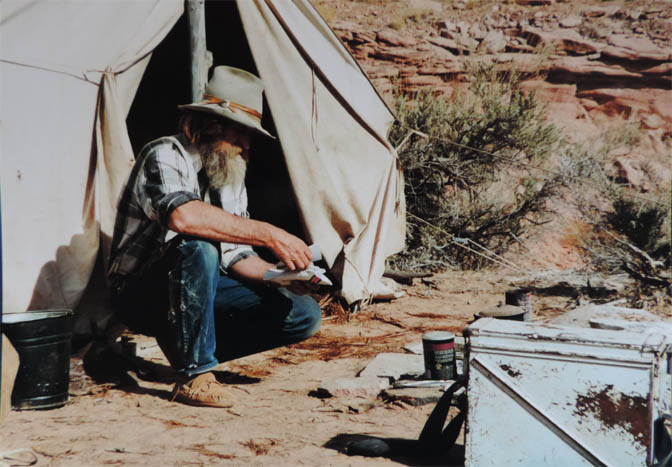
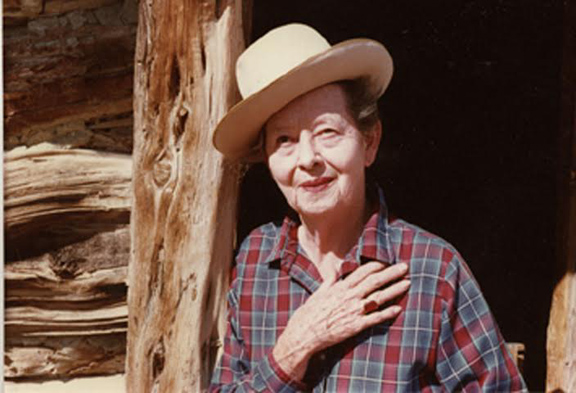
hour. Later I wrote a story about him. Recently, someone new to Moab was startled to find Nick and his camp up there on the high desert. The guy thought I should write a story about him . “I did,” I said. “…in 1996.” I showed my friend the story.
He scratched his head and said “Damn…he hasn’t changed a bit.” Once you’ve become an unconventional hermit for a quarter century, you’ve probably found your ‘look.’ (NOTE: Nik’s story is not online yet, but I’m working on it…JS)
*****
So we express gratitude for the surviving outliers, human and otherwise. Or vice versa. And yes, maybe I’ve wandered a bit from the subject of remnant forests and outlier aspen trees. But if I want to compare a grove of aspens with Toots McDougald or Jack Holley or Nik Hougen, I don’t think they’d mind. I’m sure Jack liked his goats far more than most humans. Nik and his horses share bonds few humans ever experience. I still believe that all outliers come from the same seeds, and the same roots. They share souls. And when I finally lay down for the last time, I hope somebody thinks I was at least distantly related to those trees and Nik and Jack and Toots. And Herb. The outliers may be dwindling…but they’re still here. And still kicking. And maybe, eventually, I can add just one more to the count.
You can never have too many outliers.
*****
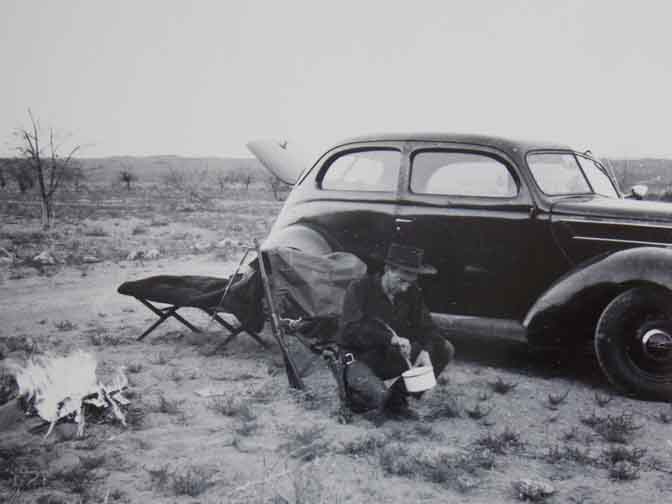
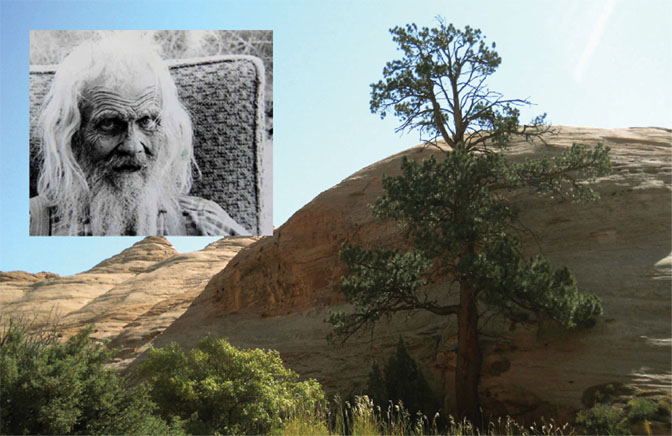

Jim Stiles is the founding publisher and editor of The Zephyr. Please note that after a last minute re-reading of this story, I sensed that I may have been inebriated during parts of its composition… cczephyr@gmail.com
“Clinging Hopelessly to the Past Since 1989”
TO COMMENT ON THIS STORY, PLEASE, WE BEG OF YOU, SCROLL TO THE BOTTOM OF THIS PAGE

BE SURE TO LOOK IN THE PROMOTIONS FOLDER…Gmail INSISTS!!!

Why they can’t just leave the site alone is beyond me,
but that’s what Facebook likes to do.
ALSO NOTE: I post old photographs and stories from our 25 year old archives every day. Pictures from Herb Ringer, Edna Fridley, Charles Kreischer.. even a few old photos from my Dad. So if you want to stay caught up on our amazing historic photo collections,
be sure to “follow” us on Facebook…Thanks…Jim
https://www.facebook.com/FansoftheCanyonCountryZephyr/

https://www.facebook.com/profile.php?id=100086441524150

Thanks to them, our bills were almost completely covered.
Now I’d like to return the favor. Check out the link below and their online shop… JS
https://www.depuygallery.com/shop.html
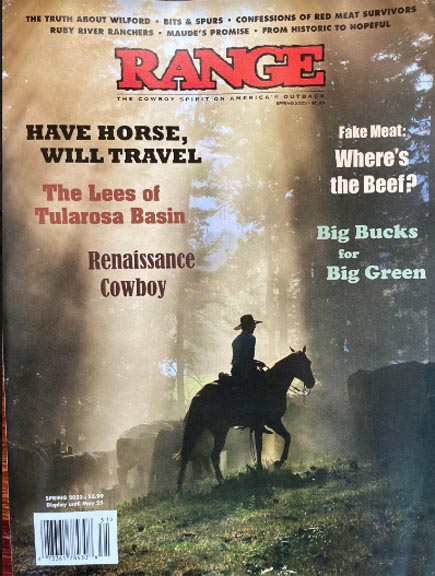
https://rangemagazine.com/subscribe/index.htm

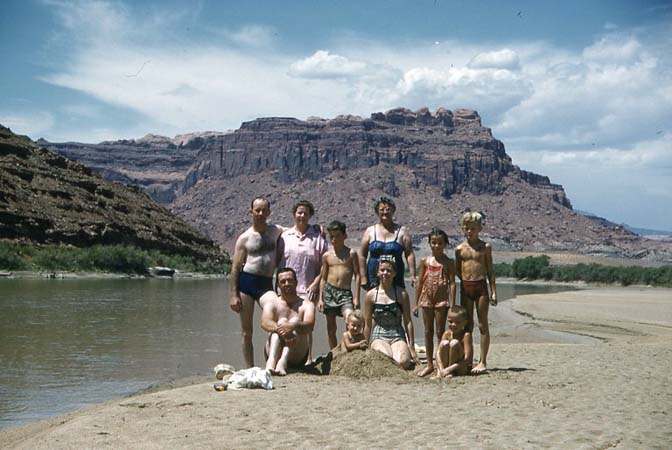
EXCERPT:
These trees, I thought to myself, are holy trees. Just like that lonely Ponderosa. Miracles of Nature…The outliers. Living entities that defy what “makes sense.” They laugh at the impossible. They are here despite every reason to deny their existence. I love these trees.
But am I being too…anthropomorphic? Am I foolishly attaching human qualities to these survivors? Maybe I am. Ultimately we’re all victims or beneficiaries of luck and unbridled fate. But maybe I want to see the same resilience in humans. I want to applaud their stubborn refusal to give up, to surrender to humanity’s inevitable fate.
I’m grateful to those human outliers, scraping out a life, way out there on the edge, refusing to acknowledge the fate that inevitably awaits our species. Those…rugged individuals… a word now considered blasphemous by some of America’s most vocal (and wealthy) environmentalists. Those crusty souls who refuse to accept their designated fate, who repudiate the notion that our future lies in the “collective.”
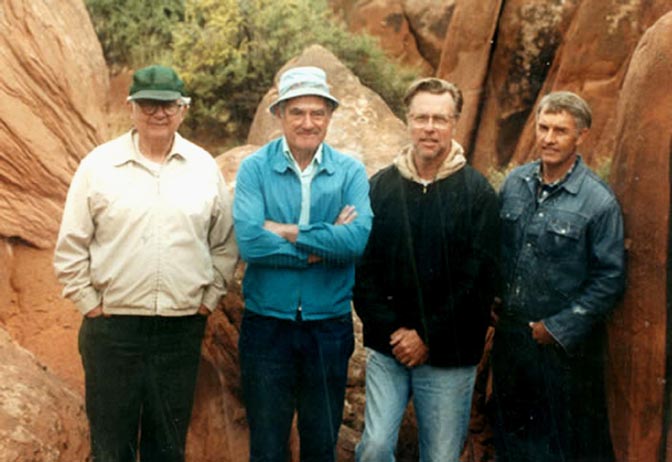
https://www.canyoncountryzephyr.com/2023/02/19/an-interview-w-ed-mccarrick-ww-ii-hero-at-the-bulge-famous-moab-arch-hunter-w-jim-stiles-zx50/
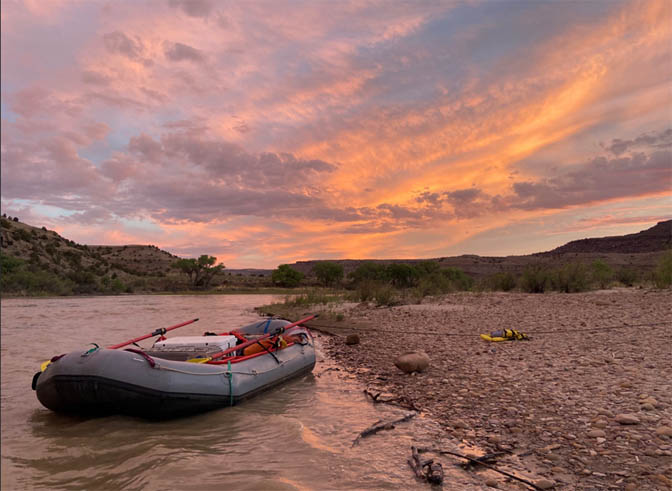
By Brandon Hill (ZX#49)
https://www.canyoncountryzephyr.com/2023/02/12/desolation-and-abundance-the-unexpected-comfort-of-canyon-rapids-origin-family-by-brandon-hill-zx49/

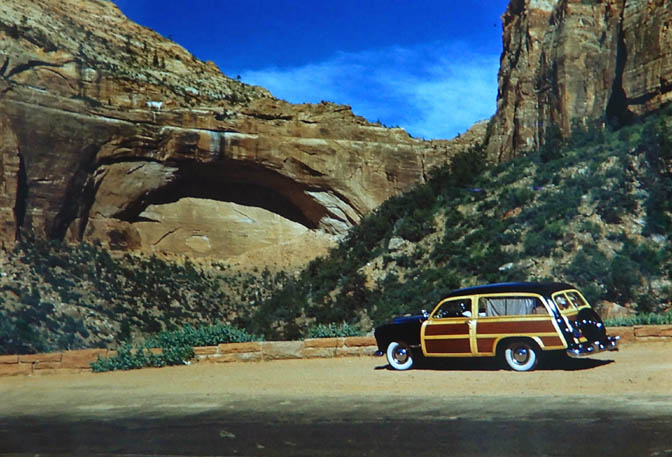
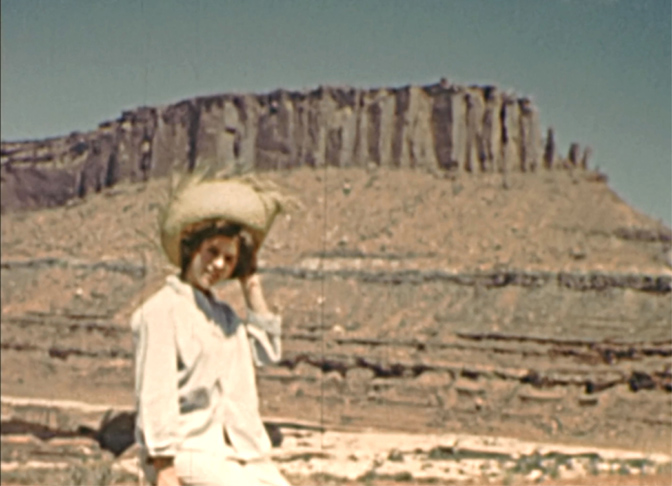

FREE
https://www.canyoncountryzephyr.com/
:





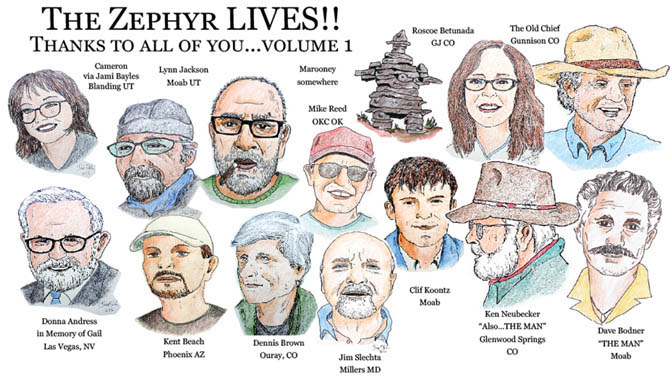
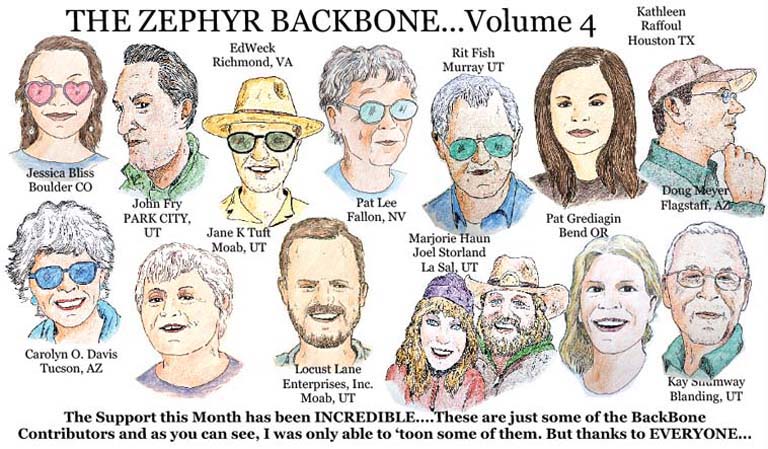
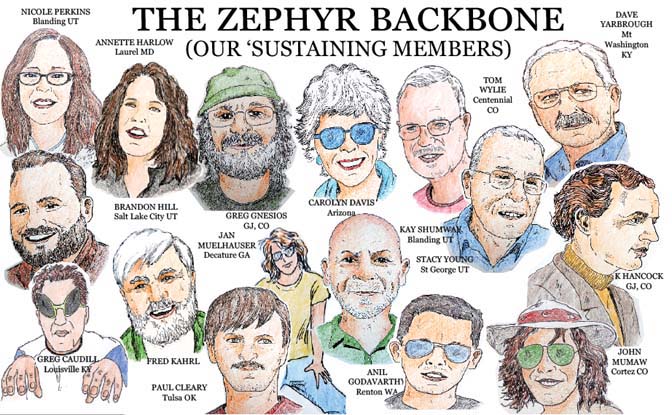
Left to its own, nature will do what it will do. There are not a lot of remnant populations left, of trees or other living things, especially where Industrial Tourism has forced its hand. I know of a remnant herd of pure-blood bison in the Henry’s. Although they are a pure genetic strain of American bison, there were placed there many decades ago as part of an experiment to see if they could thrive in an extra-prairie terrain.
My favorite among your photos is the ponderosa pine tree snuggered up against the slickrock cliff. It’s as if the tree were seeking to hide itself in a cleft of the rock; a shelter against time and change.
Very nicely done; some outstanding writing, and a good direction for the author. I knew Nik during my time in Moab–interesting guy. Can’t wait to read the article.
Very interesting Jim. I know of at least two ponderosa which are where they are not supposed to be. One is in Bull Pup canyon north east of Blanding. It is an old giant growing in mostly rock. It is slowly dying at the top but next to it is a young ponderosa that has split a boulder as it has grown and is now nearly as tall as the old giant. I have been watching those two for about 40 years. Another lonely ponderosa is in the bottom of Mule Canyon and readily visible from highway 95.
About 40 years ago I planted several ponderosa along the road to my orchard in Bull Pup. My son runs that place now but the trees are thriving. A recent BLM visitor commented that my trees were not supposed to be there. My son pointed out that ponderosa grew wild on two places on the property. Both of those places are dry hill tops.
Not to worry, some of us might have been inebriated when we read parts of the story. Always enjoyable..
Very interesting, of course. These remnants are often studied by the science of island biogeography. Think of the sky islands all across the southwest, the remnants of all those wetter times eons ago. I didn’t know about the elevation gradient of ponderosas. We have pretty extensive ponderosa stands, especially in the shady places, in Boulder Mountain Park, easily down to 5800 ft elevation. The one I planted in my yard in the early 90s is thriving at 5500 (Not planted by a bird, but by a human). There are stands of aspen in Roxborough State Park, just sw of Denver. They are a miracle of oddball outliers for sure. Your article reminds me of so many special places that just don’t ever make the map.
I-15 between LA and Las Vegas climbs to a broad saddle called (surprise) Mountain Pass, east of Baker, Calif. To the north at the crest of the pass, a impressive desert peak called Clark Mountain (7,929′) rears up. In the heart of the Mojave — in a land of yuccas and Joshua trees — there is an utterly isolated,very small remnant Pleistocene white fir (Abies concolor) forest just below the summit on the shaded north face of the peak. I’ve climbed Clark and seen it with my own eyes. Just amazing!,
Wow I’ve been reading your stories for 33 years and have pretty much enjoyed all of them. Don’t quite how Facebook went sideways on you and the article. Another good reason I don’t do social media. But please keep up the good work.
The mammoth evidence in Glen Canyon is fascinating, Bechan Cave etc. Massive retreat to higher elevations for the vegetation that was here back in the Ice Ages…
Facefuck is poisonous and that is why I never go there.
Politicising Beth’s melons is beneath contempt.
I had similar censorship on Wayne’s Words (ostensibly a site for fishing folk) when I pointed out that ‘Lake Powell’ was just another reservoir. Oh boy, did that trigger them.
They, WW, as with all shady outfits, hide beneath a credible frontman, in this case one Wayne Gustaveson. He HAS been fishing the reservoir since the eighties but has little to no involvement with the blog that still carries his name.
The ‘moderators’ on there go by such exotic monikers as “Barts Place”, “JFR California” and “powell bride”. All Feds, no doubt. They don’t like that people are kicking back against their beloved failed reservoir project.
So, stiles – if Beth’s melons have been bounced it will have been from a higher power than Facebork.
Thank you for being the voice for outliers, here today, and those gone. All very special people, as you are. Thanks for being a voice of sanity in an insane world.
Some of us are outliers in spirit, trapped in chains of responsibility. It is good to know about outliers who have broken the chains, human and otherwise. Thank you.
Some of us are outliers in spirit, trapped in chains of responsibility. It is good to know about outliers who have broken the chains, human and otherwise. Thank you.
Yes we are
Hi Jim. Another outlier just died, Don vizzini. I submitted an obit and a great Pic to the TI.
best,
Terry
I too am looking forward to reading Nik Hougen’s story!
There is a decent-sized grove of aspens in Kane Gulch. The BLM says seeds were deposited there during the last Ice Age and its related glacial incursion. I wonder if they could also be considered “outliers.”
I love this story. For a while now I’ve been attracted to similar oddities in my area.
The Awapa Plateau has small groves and loners with a similarly secluded feeling to the grove you discovered in NM, albeit less isolated.
Closer to home, there’s an Aspen stand along the Escalante River growing at 5,500′.
Another surprise hiding in a tributary of a tributary is a 60′ tall Colorado Blue Spruce at 5,700′.
There is a very small grove of quaking aspen on the northeast side of the San Bernardino Mountains in Southern California, northeast of Big Bear Lake as I remember. There are NO other aspens in ALL the California mountains below the Sierras, No one knows how they got there.